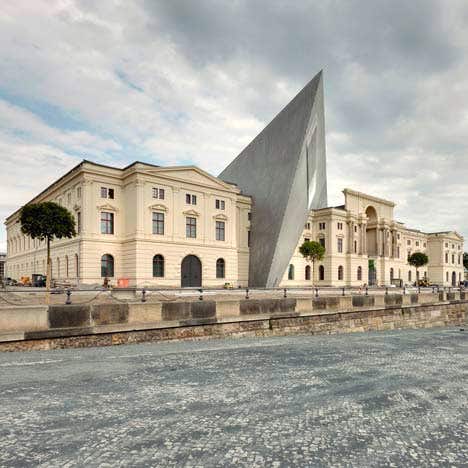
Clem Labine
Daniel Libeskind’s Architectural Aggression
A recent museum addition by Daniel Libeskind provides vivid evidence of the disdain that many Modernist architects hold not only for traditional design, but also for the work of their professional predecessors. The building in question is an addition to the Military Museum in Dresden, Germany. Not content with merely affixing an unsympathetic, context-defying appendage to the original Neoclassical building, Libeskind took the additional step of slicing through the façade of the older structure to emphasize his total disregard for historic fabric.
Interestingly, to avoid the charge of mere personal grandiosity and ego projection, Libeskind has chosen to cloak his Dresden work in political terms. Says Libeskind, “The new façade’s openness and transparency contrast with the opacity and rigidity of the existing building. The latter represents the severity of the authoritarian past. while the former reflects the openness of the democratic society in which it has been reimagined.”
To assert that the 19th-century Neoclassical façade represents “the severity of the authoritarian past” is the hoary rhetorical device of attempting to link architectural style to political beliefs. Modernists frequently deride Classicism because it was a style used during the Fascist era. This argument totally ignores the fact that Classicism has been employed by regimes of all political stripes throughout the ages. Does Libeskind also contend that the U.S. Capitol’s Classical “opacity and rigidity” represent “the authoritarian past?” Does Libeskind’s creation represent “the openness of a democratic society” more than Thomas Jefferson’s Classical scheme for the University of Virginia?
Does Classicism belong to a political party?
Ironically, if Mies van der Rohe had prevailed, classicists today would be deriding Modernism as “Fascist design.” Mies spent much of the mid-1930s – encouraged by the Nazis' chief propagandist, Josef Goebbels – attempting to win commissions from the Nazi regime. It was the chance meeting between Hitler and the young Albert Speer that undid Mies’s career as a budding Nazi architect. It was only in 1937 – after despairing of ever winning any major commissions from the Nazis – did Mies move to the U.S. and unleash his theories on American architectural education. If Goebbels’s taste for Modernism had triumphed, today we would be denouncing the rigidity and coldness of Modernism as symbolic of “the authoritarian past” of the Nazi era.
Libeskind’s false – but widely believed – linking of architectural style to outmoded political beliefs should give pause to those in the traditional design community who have cautioned against speaking out about the absurdities of Modernist polemics. “There’s plenty of room for both Modernist and traditional architecture,” they contend, and add: “People don’t like negative arguments.” Perhaps that’s true. But to this observer, it seems that the Modernists who deride traditional design are the ones getting the big public commissions today. This does not seem to be the time for unilateral disarmament.
Clem Labine is the founder of Old-House Journal, Clem Labine’s Traditional Building, and Clem Labine’s Period Homes. His interest in preservation stemmed from his purchase and restoration of an 1883 brownstone in the Park Slope section of Brooklyn, NY.
Labine has received numerous awards, including awards from The Preservation League of New York State, the Arthur Ross Award from Classical America and The Harley J. McKee Award from the Association for Preservation Technology (APT). He has also received awards from such organizations as The National Trust for Historic Preservation, The Victorian Society, New York State Historic Preservation Office, The Brooklyn Brownstone Conference, The Municipal Art Society, and the Historic House Association. He was a founding board member of the Institute of Classical Architecture and served in an active capacity on the board until 2005, when he moved to board emeritus status. A chemical engineer from Yale, Labine held a variety of editorial and marketing positions at McGraw-Hill before leaving in 1972 to pursue his interest in preservation.









